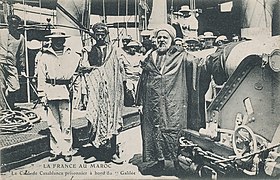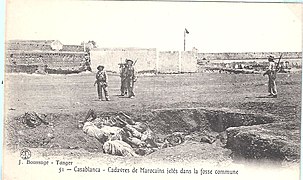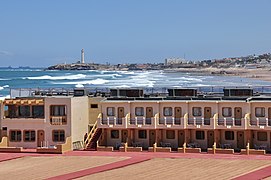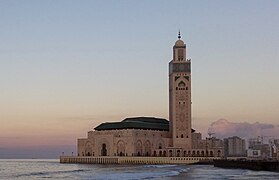Casablanca
Casablanca
الدار البيضاء ( Arabic) Al-Dār al-Bayḍāʾ | |
|---|---|
From top, left to right: Hassan II Mosque, Twin Center, United Nations Square, Arab League Park, Casablanca Tramway | |
|
UTC+1 (CET) | |
| Postal code | 20000-20200 |
| Website | www |
Casablanca (
Casablanca is Morocco's chief port, with the
Casablanca is a significant financial centre, ranking 54th globally in the September 2023 Global Financial Centres Index rankings, between Brussels and Rome.[5] The Casablanca Stock Exchange is Africa's third-largest in terms of market capitalization, as of December 2022.[6]
Major Moroccan companies and many of the largest American and European companies operating in the country have their headquarters and main industrial facilities in Casablanca. Recent industrial statistics show that Casablanca is the main industrial zone in the country.
Etymology
Anfa
Before the 15th century, the settlement at what is now Casablanca had been called Anfa, rendered in European sources variously as El-Anfa, Anafa or Anaffa, Anafe, Anife, Anafee, Nafe, and Nafee.[7] Ibn Khaldun ascribed the name to the Anfaça, a branch of the Auréba tribe of the Maghreb, though the sociologist André Adam refuted this claim due to the absence of the third syllable.[7] Nahum Slouschz gave a Hebrew etymology, citing the Lexicon of Gesenius: anâphâh (a type of bird) or anaph (face, figure), though Adam refuted this arguing that even a Judaized population would still have spoken Tamazight.[7] Adam also refuted an Arabic etymology, أنف (anf, "nose"), as the city predated the linguistic Arabization of the country, and the term anf was not used to describe geographic areas.[7] Adam affirmed a Tamazight etymology—from anfa "hill", anfa "promontory on the sea", ifni "sandy beach", or anfa "threshing floor"—although he determined the available information insufficient to establish exactly which.[7]
The name "Anfa" was used in maps until around 1830—in some until 1851—which Adam attributes to the tendency of cartographers to replicate previous maps.[8]
Casablanca

When Sultan Mohammed ben Abdallah (c. 1710–1790) rebuilt the city after its destruction in the earthquake of 1755, it was renamed "ad-Dār al-Bayḍāʾ " (الدار البيضاء The White House), though in vernacular use it was pronounced "Dar al-Baiḍā" (دار البيضاء literally House of the White, although in Moroccan Arabic vernacular it retains the original sense of The White House).[8]
The origins of the name "Casablanca" are unclear, although several theories have been suggested. André Adam mentions the legend of the Sufi saint and merchant Allal al-Qairawani, who supposedly came from Tunisia and settled in Casablanca with his wife Lalla al-Baiḍāʾ (لالة البيضاء White Lady).[8] The villagers of Mediouna would reportedly provision themselves at "Dar al-Baiḍāʾ" (دار البيضاء House of the White).[8]
In fact, on a low hill slightly inland above the
During the
History
Early history
The area that is today Casablanca was founded and settled by
Portuguese conquest and Spanish influence

In the early 15th century, the town became an independent state once again, and emerged as a safe harbour for pirates and
The town was finally rebuilt between 1756 and 1790 by
Colonial struggle
In the 19th century, the area's population began to grow as it became a major supplier of wool to the booming textile industry in
Bombardment of Casablanca
The Treaty of Algeciras of 1906 formalized French preeminence in Morocco and included three measures that directly impacted Casablanca: that French officers would control operations at the customs office and seize revenue as collateral for loans given by France, that the French holding company La Compagnie Marocaine would develop the port of Casablanca, and that a French-and-Spanish-trained police force would be assembled to patrol the port.[20]
To build the port's breakwater, narrow-gauge track was laid in June 1907 for a small Decauville locomotive to connect the port to a quarry in Roches Noires, passing through the sacred Sidi Belyout graveyard. In resistance to this and the measures of the 1906 Treaty of Algeciras, tribesmen of the Chaouia attacked the locomotive, killing 9 Compagnie Marocaine laborers—3 French, 3 Italians, and 3 Spanish.[21]
In response, the French
As Oujda had already been occupied, the bombardment and military invasion of the city opened a western front to the French military conquest of Morocco.
-
A man inspects the derailed Decauville locomotive at the scene of the attack that served as the pretext for the French bombardment of Casablanca in 1907.[24][25]
-
A postcard showing the French cruiserbombardment of CasablancaAugust 1907.
-
Moroccan cadavers in a mass grave in 1907.
French rule and influence
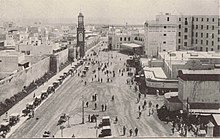
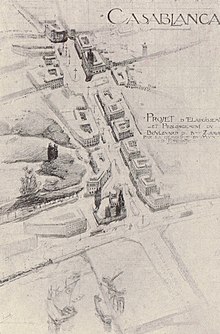
French control of Casablanca was formalized March 1912 when the
Right at the beginning of the twentieth century when Morocco was officially declared a French protectorate, the French decided to shift power to Morocco's coastal areas (i.e. Rabat and Casablanca) at the expense of its interior areas (i.e. Fez and Marrakech). Rabat was made the administrative capital of the country and Casablanca its economic capital. [29]
General
Europeans formed almost half the population of Casablanca.[31]
A 1937-1938 typhoid fever outbreak was exploited by colonial authorities to justify the appropriation of urban spaces in Casablanca.[32][33] Moroccans residing in informal housing were cleared out of the center and displaced, notably to Carrières Centrales.[32]
World War II
After Philippe Pétain of France signed the armistice with the Nazis, he ordered French troops in France's colonial empire to defend French territory against any aggressors—Allied or otherwise—applying a policy of "asymmetrical neutrality" in favour of the Germans.[34] French colonists in Morocco generally supported Pétain, while Moroccans tended to favour de Gaulle and the Allies.[35]
Casablanca was the site of the
Anfa Conference
Casablanca hosted the
It was at this conference that the Allies adopted the doctrine of "unconditional surrender", meaning that the Axis powers would be fought until their defeat. Roosevelt also met privately with Sultan Muhammad V and expressed his support for Moroccan independence after the war.[37] This became a turning point, as Moroccan nationalists were emboldened to openly seek complete independence.[37]
Toward independence
During the 1940s and 1950s, Casablanca was a major centre of anti-French rioting.
On 7 April 1947, a
Since independence
Morocco gained independence from France in 1956. The post-independence era witnessed significant urban transformations and socio-economic shifts, particularly in neighborhoods like Hay Mohammadi, which were deeply impacted by neoliberal policies and state-led urban redevelopment projects.[41]
Casablanca Group
On 4–7 January 1961, the city hosted an ensemble of progressive African leaders during the Casablanca Conference of 1961. Among those received by King Muhammad V were Gamal Abd An-Nasser, Kwame Nkrumah, Modibo Keïta, and Ahmed Sékou Touré, Ferhat Abbas.[25][42][43]
Jewish emigration
Casablanca was a major departure point for Jews leaving Morocco through Operation Yachin, an operation conducted by Mossad to secretly migrate Moroccan Jews to Israel between November 1961 and spring 1964.[44]
1965 riots
The 1965 student protests organized by the National Union of Popular Forces-affiliated National Union of Moroccan Students, which spread to cities around the country and devolved into riots, started on 22 March 1965, in front of Lycée Mohammed V in Casablanca.[45][46][47] The protests started as a peaceful march to demand the right to public higher education for Morocco, but expanded to include concerns of labourers, the unemployed, and other marginalized segments of society, and devolved into vandalism and rioting.[48] The riots were violently repressed by security forces with tanks and armoured vehicles; Moroccan authorities reported a dozen deaths while the UNFP reported more than 1,000.[45]
King Hassan II blamed the events on teachers and parents, and declared in a speech to the nation on 30 March 1965: "There is no greater danger to the State than a so-called intellectual. It would have been better if you were all illiterate."[49][50]
1981 riots
On 6 June 1981, the
Mudawana
In March 2000, more than 60 women's groups organized demonstrations in Casablanca proposing reforms to the legal status of women in the country.
Further history
On 16 May 2003, 33 civilians were killed and more than 100 people were injured when Casablanca was hit by a multiple suicide bomb attack carried out by Moroccans and claimed by some to have been linked to al-Qaeda. Twelve suicide bombers struck five locations in the city.[56]
Another series of suicide bombings struck the city in early 2007.[57][58][59] These events illustrated some of the persistent challenges the city faces in addressing poverty and integrating disadvantaged neighborhoods and populations.[60] One initiative to improve conditions in the city's disadvantaged neighborhoods was the creation of the Sidi Moumen Cultural Center.[60]
As calls for reform spread through the Arab world in 2011, Moroccans joined in, but concessions by the ruler led to acceptance.[citation needed] However, in December, thousands of people demonstrated in several parts of the city[citation needed], especially the city center near la Fontaine, desiring more significant political reforms. On 1 November 2023, Casablanca along with Ouarzazate joined UNESCO's Creative Cities Network.[61][62]
Geography

Casablanca is located on the Atlantic coast of the Chaouia Plains, which have historically been the breadbasket of Morocco.[63] Apart from the Atlantic coast, the Bouskoura forest is the only natural attraction in the city.[64] The forest was planted in the 20th century and consists mostly of eucalyptus, palm, and pine trees.[65] It is located halfway to the city's international airport.
The only watercourse in Casablanca is oued Bouskoura,
Climate
Casablanca has a
| Climate data for Casablanca (1991–2020 normals, extremes 1941–2020) | |||||||||||||
|---|---|---|---|---|---|---|---|---|---|---|---|---|---|
| Month | Jan | Feb | Mar | Apr | May | Jun | Jul | Aug | Sep | Oct | Nov | Dec | Year |
| Record high °C (°F) | 31.3 (88.3) |
35.3 (95.5) |
37.3 (99.1) |
36.2 (97.2) |
38.6 (101.5) |
38.6 (101.5) |
42.2 (108.0) |
40.8 (105.4) |
40.6 (105.1) |
37.8 (100.0) |
35.0 (95.0) |
30.3 (86.5) |
42.2 (108.0) |
| Mean daily maximum °C (°F) | 17.6 (63.7) |
18.1 (64.6) |
19.7 (67.5) |
20.6 (69.1) |
22.7 (72.9) |
24.6 (76.3) |
26.1 (79.0) |
26.7 (80.1) |
25.9 (78.6) |
24.3 (75.7) |
21.0 (69.8) |
18.9 (66.0) |
22.2 (72.0) |
| Daily mean °C (°F) | 13.3 (55.9) |
13.9 (57.0) |
15.7 (60.3) |
17.0 (62.6) |
19.4 (66.9) |
21.7 (71.1) |
23.3 (73.9) |
23.9 (75.0) |
22.7 (72.9) |
20.6 (69.1) |
17.0 (62.6) |
14.7 (58.5) |
18.6 (65.5) |
| Mean daily minimum °C (°F) | 8.9 (48.0) |
9.7 (49.5) |
11.6 (52.9) |
13.3 (55.9) |
15.9 (60.6) |
18.7 (65.7) |
20.5 (68.9) |
21.0 (69.8) |
19.5 (67.1) |
16.8 (62.2) |
12.8 (55.0) |
10.5 (50.9) |
14.9 (58.8) |
| Record low °C (°F) | −1.5 (29.3) |
0.3 (32.5) |
2.8 (37.0) |
5.0 (41.0) |
7.2 (45.0) |
10.0 (50.0) |
12.0 (53.6) |
13.0 (55.4) |
10.8 (51.4) |
7.0 (44.6) |
2.0 (35.6) |
1.0 (33.8) |
−1.5 (29.3) |
| Average precipitation mm (inches) | 61.9 (2.44) |
49.7 (1.96) |
42.5 (1.67) |
33.5 (1.32) |
13.6 (0.54) |
2.5 (0.10) |
0.5 (0.02) |
0.4 (0.02) |
11.7 (0.46) |
45.3 (1.78) |
84.4 (3.32) |
62.2 (2.45) |
408.2 (16.07) |
| Average precipitation days (≥ 1.0 mm) | 6.5 | 6.1 | 6.0 | 4.7 | 2.2 | 0.7 | 0.1 | 0.0 | 1.8 | 5.1 | 6.7 | 6.5 | 46.4 |
| Average relative humidity (%)
|
83 | 83 | 82 | 80 | 79 | 81 | 82 | 83 | 83 | 82 | 82 | 84 | 82 |
| Mean monthly sunshine hours | 203.0 | 200.0 | 246.8 | 269.4 | 305.4 | 296.0 | 305.1 | 297.2 | 263.1 | 240.8 | 208.0 | 195.2 | 3,030 |
| Source 1: NOAA (sun 1981–2010)[67][68] | |||||||||||||
| Source 2: Deutscher Wetterdienst (humidity 1949–1993, extremes 1941–1993)[69] | |||||||||||||
| Jan | Feb | Mar | Apr | May | Jun | Jul | Aug | Sep | Oct | Nov | Dec |
|---|---|---|---|---|---|---|---|---|---|---|---|
| 17.5 °C (63.5 °F) | 17.0 °C (62.6 °F) | 17.1 °C (62.8 °F) | 18.4 °C (65.1 °F) | 19.5 °C (67.1 °F) | 21.8 °C (71.2 °F) | 22.7 °C (72.9 °F) | 23.3 °C (73.9 °F) | 23.1 °C (73.6 °F) | 22.5 °C (72.5 °F) | 20.4 °C (68.7 °F) | 18.5 °C (65.3 °F) |
Climate change
A 2019 paper published in PLOS One estimated that under Representative Concentration Pathway 4.5, a "moderate" scenario of climate change where global warming reaches ~2.5–3 °C (4.5–5.4 °F) by 2100, the climate of Casablanca in the year 2050 would most closely resemble the current climate of Tripoli, Libya. The annual temperature would increase by 1.7 °C (3.1 °F), and the temperature of the warmest month by 1.6 °C (2.9 °F), while the temperature of the coldest month would actually decrease by 0.2 °C (0.36 °F).[71][72]
Moreover, according to the 2022
Economy


The
One of the most important exports of Casablanca is phosphate. Other industries include fishing, fish canning, sawmills, furniture production, building materials, glass, textiles, electronics, leather work, processed food, spirits, soft drinks, and cigarettes.[76]
The Casablanca and Mohammedia seaports activity represent 50% of the international commercial flows of Morocco.[citation needed] Almost the entire Casablanca waterfront is under development, mainly the construction of huge entertainment centres between the port and Hassan II Mosque, the Anfa Resort project near the business, entertainment and living centre of Megarama, the shopping and entertainment complex of Morocco Mall, as well as a complete renovation of the coastal walkway. The Sindbad park was also renewed with rides, games and entertainment services.[77]
Casablanca is a significant financial centre, ranking 54th globally in the September 2023 Global Financial Centres Index rankings, between Brussels and Rome.[5] The Casablanca Stock Exchange is Africa's third-largest in terms of market capitalization, as of December 2022.[6]
Administrative divisions
Casablanca is a commune, part of the region of Casablanca-Settat. The commune is divided into eight districts or prefectures, which are themselves divided into 16 subdivisions or arrondissements and one municipality. The districts and their subdivisions are:[81]
- Aïn Chock (عين الشق) – Aïn Chock (عين الشق)
- Aïn Sebaâ – Hay Mohammadi (عين السبع الحي المحمدي) – Aïn Sebaâ (عين السبع), Hay Mohammadi (الحي المحمدي), Roches Noires (روش نوار).
- Anfa (أنفا) – Anfa (أنفا), Maârif (المعاريف), Sidi Belyout (سيدي بليوط).
- Ben M'Sick (بن مسيك) – Ben M'Sick (بن مسيك), Sbata (سباته).
- Sidi Bernoussi (سيدي برنوصي) – Sidi Bernoussi (سيدي برنوصي), Sidi Moumen (سيدي مومن).
- Al Fida – Mers Sultan (الفداء – مرس السلطان) – Al Fida (الفداء); Mechouar (المشور) (municipality), Mers Sultan (مرس السلطان).
- Hay Hassani (الحي الحسني) – Hay Hassani (الحي الحسني).
- Moulay Rachid (مولاي رشيد) – Moulay Rachid (مولاي رشيد), Sidi Othmane (سيدي عثمان).
Neighborhoods
The list of neighborhoods is indicative and not complete:
- 2 Mars
- Ain Chock
- Ain Diab
- Ain Sebaa
- Attacharouk
- Belvédère
- Beauséjour
- Bouchentouf
- Bouskoura
- Bourgogne
- Californie
- Centre Ville
- C.I.L.
- La Colline
- Derb Ghallef
- Derb Sultan
- Derb Tazi
- Gauthier
- Ghandi
- Habous
- El Hank
- Hay Dakhla
- Hay El Baraka
- Hay El Hanaa
- Hay El Hassani
- Hay El Mohammadi
- Hay Farah
- Hay Moulay Rachid
- Hay Salama
- Hubous
- Inara
- Laimoun (Hay Hassani)
- Lamkansa
- Lissasfa
- Maârif
- Mers Sultan
- Nassim
- Oasis
- Old Madina
- Oulfa
- Palmiers
- Polo
- Racine
- Riviera
- Roches Noires
- Salmia 2
- Sbata
- Sidi Bernoussi
- Sidi Maârouf
- Sidi Moumen
- Sidi Othmane
Demographics

The commune of Casablanca recorded a population of 3,359,818 in the
Judaism in Casablanca
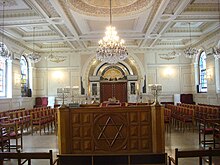
Jews have a long history in Casablanca. A Sephardic Jewish community was in Anfa up to the destruction of the city by the Portuguese in 1468. Jews were slow to return to the town, but by 1750, the Rabbi Elijah synagogue was built as the first Jewish synagogue in Casablanca. It was destroyed along with much of the town in the 1755 Lisbon earthquake.[11]
In the mid-19th century, with commercial development through European economic penetration, industrial imports from Europe drove traditional Jewish crafts out of the market, costing many Jews in the interior their traditional livelihoods.
Casablanca's mellah was ravaged in the bombardment of Casablanca of 1907, the beginning of the French invasion of Morocco from the West.[88]
Jean-Louis Cohen highlights the roll of Jewish patrons in the architecture and urban development of Casablanca, particularly in construction of the overwhelming majority of the city's tallest buildings during the interwar period.[89] One notable example of this trend is the Lévy-Bendayan Building designed by Marius Boyer.[89]
Approximately 28,000 Moroccan Jews immigrated to the State of Israel between 1948 and 1951, many through Casablanca.[90] Casablanca then became a departure point in Operation Yachin, the covert Mossad-organized migration operation from 1961 to 1964. In 2018 it was estimated that there were only 2,500 Moroccan Jews living in Casablanca,[83] while according to the World Jewish Congress there were only 1,000 Moroccan Jews remaining.[91]
Today, the Jewish cemetery of Casablanca is one of the major cemeteries of the city, and many synagogues remain in service, but the city's Jewish community has dwindled. The Moroccan Jewish Museum is a museum established in the city in 1997.[92]
Education
Colleges and universities
Public: University of Hassan II Casablanca
Private:
Primary and secondary schools
International schools:
- Belgium: École Belge de Casablanca
- French:
- Collège Anatole France
- Lycée Lyautey
- Groupe Scolaire Louis Massignon
- Lycée La Résidence
- Lycée Maïmonide (FR)
- Lycée Léon l'Africain
- École Normale Hébraïque
- École Al Jabr
- Italian: Scuola "Enrico Mattei"
- Spanish: Instituto Español Juan Ramón Jiménez
- American:
- Montessori:
- École Montessori Casablanca
Libraries
- Hassan II Mosque Foundation Multimedia Library
- King Abdul Aziz Foundation for Human Sciences and Islamic Studies
- Dar America
- Institut Français
- Instituto Cervantes
Places of worship

Most of the city's
Sports
Association football
Casablanca is home to two popular football clubs:
Raja CA, founded in 1949, compete in Botola and play their home games at the Stade Mohammed V. The club is known for their supporters and is one of the most supported teams in Africa. Wydad AC, founded in 1937, also compete in Botola and play their home games at the Stade Mohammed V. Both have a strong reputation on continental competitions, having both won the CAF Champions League three times.
Casablanca hosted eight African Champions League finals, all eight at the Stade Mohammed V. The Stade also hosted the
Tennis
Casablanca hosts The Grand Prix Hassan II, a professional men's tennis tournament of the ATP tour. It first began in 1986, and is played on clay courts type at Complexe Al Amal.
Notable winners of the Hassan II Grand-Prix are
Hosting
Casablanca staged the
Venues
- Stade Larbi Zaouli
- Stade Mohamed V
- Stade Sidi Bernoussi
- Complexe Al Amal de Casablanca
The
Road Racing
The city is host to the International Casablanca Marathon, a 26.2-mile road race that draws international competition. The race was founded in 2008 and is a member of the Association of International Marathons and Distance Races Archived 17 February 2022 at the Wayback Machine.
Culture
Music
Haja El Hamdaouia, one of the most iconic figures in aita music, was born in Casablanca.[103] Nass El Ghiwane, led by Larbi Batma, came out of Hay Mohammadi in Casablanca.[104] Naima Samih of Derb Sultan gained prominence through the program Mawahib (مواهب).[105] Abdelhadi Belkhayat and Abdelwahab Doukkali are musicians specializing in traditional Moroccan Arabic popular music.[106] Zina Daoudia, Abdelaziz Stati, Abdellah Daoudi, and Said Senhaji are notable Moroccan chaabi musicians.
Abdelakabir Faradjallah founded Attarazat Addahabia, a Moroccan funk band, in 1968.[107] Fadoul, another funk band, formed in the 1970s.[108]
Hoba Hoba Spirit also formed in Casablanca, and is still based there.[109] Casablanca has a thriving hiphop scene, with artists such as El Grande Toto, Don Big, 7liwa, and Issam Harris.[110]
Casablanca hosts numerous music festivals, such as
Literature
The French writer Antoine de Saint-Exupéry is associated with Casablanca.
Driss Chraïbi's novel The Simple Past takes place in Casablanca. Mohamed Zafzaf lived in Maarif while writing and teaching at a high school.[115]
Lamalif, a radical leftist political and cultural magazine, was based in Casablanca.
Casablanca's International Book Fair is held at the fair grounds opposite Hassan II Mosque annually in February.
Theater
Tayeb Saddiki, described as the father of Moroccan theater, grew up in Casablanca and made his career there.[116] Hanane el-Fadili and Hassan El Fad are popular comedians from Casablanca. Gad Elmaleh is another comedian from Casablanca, though he has made his career abroad.[117]
Visual art
The
The Academy of Traditional Arts, part of the Hassan II Mosque complex, was founded 31 October 2012.[121]
L'Uzine is a community-based art and culture space in Casablanca.[122]
Rebel Spirit published The Casablanca Guide (الدليل البيضاوي, Le Guide Casablancais) a comic book about life in Casablanca.[123]
Sbagha Bagha is a street art festival during which murals are created on the sides of apartment buildings.[124]
Photography
Postcard companies such as Léon & Lévy were active in Casablanca. Gabriel Veyre also worked and eventually died in Casablanca.
Marcelin Flandrin (1889-1957), a French military photographer, settled in Casablanca and recorded much of the early colonial period in Morocco with his photography.[125] With his staged nude postcard photos taken in Casablanca's colonial brothel quarter, Flandrin was also responsible for disseminating the orientalist image of Moroccan women as sexual objects.[126]
Casablanca has a thriving street photography scene.[127] Yoriyas is prominent among photographers capturing the economic capital's street scenes, and has attracted international attention.[128]
Film
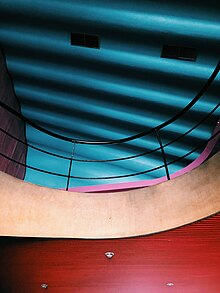
In the first half of the 20th century, Casablanca had many movie theaters, such as Cinema Rialto, Cinema Lynx and Cinema Vox, the largest in Africa when it was built.[129][130][131]
The 1942 American film Casablanca is set in Casablanca and has had a lasting impact on the city's image although it was filmed in the United States.[132] Salut Casa! was a propaganda film brandishing France's purported colonial triumph in its mission civilisatrice in the city.[133]
Mostafa Derkaoui's revolutionary independent film About Some Meaningless Events (1974) took place in Casablanca.[134] It was the main subject of Ali Essafi's documentary Before the Dying of the Light.[134]
Architecture

Casablanca's architecture and urban development are historically significant. The city is home to many notable buildings in a variety of styles, including traditional Moroccan architecture, various colonial architectural styles,
The work of the Groupe des Architectes Modernes Marocains (GAMMA) on public housing projects—such as Carrières Centrales in Hay Mohammadi—in a style described as vernacular modernism influenced modernist architecture around the world.[140][141]
Casamémoire and MAMMA. are two organizations dedicated to the preservation and appreciation of the city's architectural heritage.
Transport


Rapid transit
The
Casablanca is also planning to introduce a rapid bus network called the Casablanca Busway. The network will consist of two lines, BW1 and BW2.[144] As of October 2023, the system was operating in a testing phase and its public opening, initially planned for July 2023, was delayed due to technical problems.[145]
Since the 1970s, Casablanca had planned to build a metro system to offer some relief to the problems of traffic congestion and poor air quality.[146][147] However, the city council voted to abandon the metro project in 2014 due to high costs, and decided to continue expanding the already operating tram system instead.[148]
Air
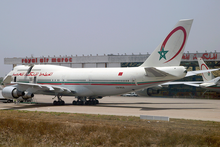
Casablanca's main airport is
, as well as other cities.Casablanca is well-served by international flights to Europe, especially French and Spanish airports, and has regular connections to North American, Middle Eastern and sub-Saharan African destinations.
are important primary destinations.The older, smaller
Coach buses
Compagnie de Transports au Maroc (CTM) offers private intercity coach buses on various lines run servicing most notable Moroccan towns, as well as a number of European cities. These run from the CTM Bus Station on Leo Africanus Street near the Central Market in downtown Casablanca. Supratours, an affiliate of ONCF, also offers coach bus service at a slightly lower cost, departing from a station on Wilad Zian Street.[149] There is another bus station farther down on the same street called the Wilad Zian Bus Station; this station is the country's largest bus station, serving over 800 buses daily, catering more to Morocco's lower income population.[150][151]
Taxis

Registered
Trains
Casablanca is served by three main railway stations run by the national rail service, the ONCF.
Casa-Oasis was originally a suburban commuter station which was fully redesigned and rebuilt in the early 21st century, and officially reopened in 2005 as a primary city rail station. Owing to its new status, all southern intercity train services to and from Casa-Voyageurs now call at Casa-Oasis. ONCF stated in 2005 that the refurbishment and upgrading of Casa-Oasis to intercity standards was intended to relieve passenger congestion at Casa-Voyageurs station.
Tourism
Although
The Hassan II Mosque, which is the second largest mosque in Africa and the seventh-largest in the world, is the city's main tourist attraction.[154][155] Visitors also come to see the city's rich architectural heritage.[156]
Popular sites for national tourism include shopping centers such as Morocco Mall, Anfa Place, the Marina Shopping Center, and the Tachfine Center. Additional sites include the Corniche and the beach of Ain Diab, and parks such as the Arab League Park or the Sindibad theme park.[157][158][159]
Notable people

- Lahcen Abrami – former Moroccan footballer
- Amine Atouchi – Moroccan footballer
- Khalil Azmi – former Moroccan goalkeeper
- Amal Ayouch Moroccan stage and film actress
- Wissam Baraka – Moroccan footballer
- Salaheddine Bassir – Moroccan footballer
- Laarbi Batma – Moroccan musician and artist, founding member of Nas El Ghiwan
- Larbi Benbarek – Moroccan footballer
- Badr Benoun – Moroccan footballer
- Miriem Bensalah-Chaqroun – Moroccan businesswoman
- Jean-Paul Bertrand-Demanes – French footballer
- Frida Boccara – French singer, winner of the Eurovision Song Contest 1969
- Aziz Bouderbala – former Moroccan footballer
- Merieme Chadid – Moroccan astronomer
- Mustapha Chadili – former goalkeeper
- Achraf Dari – Moroccan footballer
- Jean-Charles de Castelbajac – Moroccan/French fashion designer
- Nabil Dirar – Moroccan footballer
- Abdelmajid Dolmy – former Moroccan footballer
- Dizzy DROS – Moroccan rapper
- Issam El Adoua – Moroccan footballer
- Badr El Kaddouri – former Moroccan footballer
- Talal El Karkouri – former Moroccan footballer
- Gad Elmaleh – French/Canadian/Moroccan comedian
- Bouchaib El Moubarki – former Moroccan footballer
- Youssef Fertout – Moroccan manager
- La Fouine – Moroccan/French rapper
- Khalid Fouhami – former Moroccan goalkeeper
- Mohamed Fouzair – Moroccan footballer
- Divina Frau-Meigs – Moroccan sociologist and professor
- El Haqed– Moroccan rapper
- Serge Haroche – French physicist, awarded the 2012 Nobel Prize for Physics
- Shatha Hassoun – Moroccan/Iraqi singer
- Lydia Hatuel-Czuckermann – Israeli Olympic fencer
- Mouhcine Iajour – Moroccan footballer
- Driss Joumad – former Morocco international footballer
- Nadir Lamyaghri – former Moroccan goalkeeper
- Hamza Mendyl – Moroccan footballer
- Hicham Mesbahi – Moroccan boxer
- French Montana – Moroccan/American rapper
- Nawal El Moutawakel – Moroccan Olympic champion
- Hakim Mouzaki – Moroccan footballer
- Abderrahim Najah – Moroccan international basketball player
- Noureddine Naybet – Moroccan footballer
- Mostafa Nissaboury – Moroccan poet
- Hakim Noury – Moroccan film director
- Maurice Ohana – French composer
- Faouzia Ouihya – Moroccan-Canadian singer
- Azzedine Ounahi- Moroccan footballer
- Jean Reno – Hollywood actor
- Youssef Rossi – former Moroccan footballer
- Abdelilah Saber – Moroccan former footballer
- Youssef Safri – Moroccan football manager
- Jamal Sellami – Moroccan football manager
- Daniel Sivan – Israeli professor
- Alain Souchon – French songwriter
- Frank Stephenson – Moroccan/British/American award-winning automobile designer
- Hassan Saada – Moroccan boxer arrested for alleged rape before Olympic match[160]
- Sidney Taurel – naturalized American CEO of Eli Lilly and Company from 1998 to 2008
- Richard Virenque – French cyclist
- Muhammad Zarqtuni – Moroccan nationalist and resistance leader
- Abdallah Zrika – Moroccan poet
In popular culture

- The 1942 film Casablanca (starring Ingrid Bergman and Humphrey Bogart) is supposed to have been set in Casablanca, although it was filmed entirely in Los Angeles and does not feature a single Arab or North African character with a speaking role.[161] The film depicts Casablanca as the scene of power struggle between various foreign powers, which had much more to do with the Tangier of the time.[162] The film has achieved worldwide popularity since its release. Nominated for eight Academy Awards, it won three, including Best Picture.
- A Night in Casablanca (1946) was the 12th Marx Brothers' movie. The film stars Groucho Marx, Chico Marx, and Harpo Marx. It was directed by Archie Mayo and written by Joseph Fields and Roland Kibbee. The film contains the song "Who's Sorry Now?", with music by Ted Snyder and lyrics by Bert Kalmar and Harry Ruby. It is sung in French by Lisette Verea playing the part of Beatrice Rheiner, and then later sung in English. Liszt's "Hungarian Rhapsody No. 2" is played twice, once by Chico on piano as an introduction to the "Beer Barrel Polka", and again by Harpo on the harp.
- The city is featured in The Mysterious Caravan (1975), volume 54 in the original Hardy Boys series.
- Casablanca is the setting for several chapters in Doubleshot, a 2000 James Bond novel by Raymond Benson. In the novel, one of the characters mentions that the 1942 film was shot in Hollywood and not on location.
- Casablanca is one of the key locations in the 2006 video game Zoë Castillo, lives. Although the city is imagined in the year 2219, much of the present-day architecture is used for inspiration.
- Casablanca is the setting for the first act of the 2016 World War II romantic thriller film Allied starring Brad Pitt and Marion Cotillard.
Twin towns – sister cities
Casablanca is twinned with:[163]
Casablanca also has cooperation agreements with:[163]
 Abuja, Nigeria
Abuja, Nigeria Amman, Jordan
Amman, Jordan Amsterdam, Netherlands
Amsterdam, Netherlands Barcelona, Spain
Barcelona, Spain Buenos Aires, Argentina
Buenos Aires, Argentina Hebron, Palestine
Hebron, Palestine Istanbul, Turkey
Istanbul, Turkey Kajiado, Kenya
Kajiado, Kenya Koudougou, Burkina Faso
Koudougou, Burkina Faso Montreal, Canada
Montreal, Canada Moroni, Comoros
Moroni, Comoros Nouakchott, Mauritania
Nouakchott, Mauritania Paris, France
Paris, France Ramallah, Palestine
Ramallah, Palestine Rotterdam, Netherlands
Rotterdam, Netherlands Brussels, Belgium[165]
Brussels, Belgium[165] Madrid, Spain
Madrid, Spain London, United Kingdom
London, United Kingdom San Sebastián, Spain
San Sebastián, Spain
 Bucharest, Roumania
Bucharest, Roumania
See also
References
Citations
- ^ "HCP : Le Grand Casablanca compte 4.270.750 habitants". aujourdhui.ma (in French). 5 May 2015. Archived from the original on 4 November 2016. Retrieved 25 April 2020.
- ^ a b "POPULATION LÉGALE DES RÉGIONS, PROVINCES, PRÉFECTURES, MUNICIPALITÉS, ARRONDISSEMENTS ET COMMUNES DU ROYAUME D'APRÈS LES RÉSULTATS DU RGPH 2014" (in Arabic and French). High Commission for Planning, Morocco. 8 April 2015. Archived from the original on 10 October 2017. Retrieved 29 September 2017.
- ^ Kjeilen, Tore (April 2020). "Casablanca". LookLex Encyclopaedia. Archived from the original on 17 December 2010. Retrieved 14 April 2020.
- ^ mystarco (2022-04-07). "Top 10 ports in Africa in 2019 (by volume in TEUs) and port projects in West Africa". ACS Africa Container Shipping | Specialized logistic solutions provider. Archived from the original on 2023-12-19. Retrieved 2024-01-10.
- ^ a b "The Global Financial Centres Index 34" (PDF). www.longfinance.net. September 2023. Archived (PDF) from the original on 2024-01-06. Retrieved 2024-01-21.
- ^ SSRN 4310296.
- ^ from the original on 2021-03-16. Retrieved 2021-04-02.
- ^ from the original on 2021-03-16. Retrieved 2021-04-02.
- ISBN 2-85036-195-X.
- ISBN 978-1-135-97876-1. Archivedfrom the original on 2023-04-02. Retrieved 2023-03-09.
However, in the sixteenth century the Portuguese decided to come back to the area and settle in it permanently. They built the city and named it Casa Branca "the white house". In 1755, the Portuguese abandoned the city after an earthquake that destroyed it completely. After the departure of the Portuguese, Casablanca remained deserted until the Alaouite Sultan Sidi Mohammed Ben Abdellah rebuilt it near the end of the eighteenth century. He renamed it Addaru lbayḍaʔ, which is the literal Arabic translation for Casa Branca. The city acquired its Spanish name Casa Blanca when Spanish companies established themselves in the city in 1781. Today the city is known by its Standard Arabic name addaru lbayḍaʔ, and d-dar(l)biḍa in Moroccan Arabic, as well as Casablanca or Casa for short.
- ^ a b "Casablanca". Jewishvirtuallibrary.org. Archived from the original on 17 July 2011. Retrieved 17 April 2011.
- ^ "Museum of History & Holocaust Education: Creating Community Collaboration". Kennesaw.edu. Archived from the original on 19 July 2011. Retrieved 17 April 2011.
- ^ Britannica, Casablanca Archived 2016-08-04 at the Wayback Machine, britannica.com, USA, accessed on 7 July 2019
- ISBN 84-86839-85-8)
- ISBN 978-1-57958-282-1. Retrieved 22 April 2012.
- ISBN 9780276398261. Retrieved 22 April 2012.
- ISBN 978-0-7146-5432-4. Retrieved 22 April 2012.
- ^ Pennel, CR: Morocco from Empire to Independence, Oneworld, Oxford, 2003, p 121
- ^ Pennel, CR: Morocco from Empire to Independence, Oneworld, Oxford, 2003, p 149.
- ^ Adam, André (1968). Histoire de Casablanca, des origines à 1914. Éditions Ophrys. p. 107.
- ^ Adam, André (1968). Histoire de Casablanca, des origines à 1914. Éditions Ophrys. p. 112.
- ^ Hachim, Mouna (April 2020). "Casablanca, mon amour: Il y a 100 ans, le bombardement... Par Mouna Hachim, écrivain-chercheur". L'Economiste. Archived from the original on 7 November 2022. Retrieved 7 November 2022.
- ^ Adam, André (1968). Histoire de Casablanca: des origines à 1914. Aix-en-Provence: Ophrys. p. 133.
- from the original on 2020-07-06. Retrieved 2021-04-03.
- ^ a b "La Conférence de Casablanca". Zamane (in French). 30 November 2012. Archived from the original on 22 April 2019. Retrieved 1 June 2019.
- ^ Comité des foires du Maroc Auteur du texte (15 August 1917). "France-Maroc : revue mensuelle illustrée : organe du Comité des foires du Maroc / directeur Alfred de Tarde". Gallica (in French). Archived from the original on 3 October 2021. Retrieved 17 October 2019.
- from the original on 2020-04-30. Retrieved 2019-07-13.
- ISBN 978-1-137-32798-7, retrieved 16 December 2022
- OCLC 154677539.
Rabat was made the administrative capital of the country and Casablanca its economic capital.
- ^ Hodebert, Laurent. ""Laprade et Prost, du Maroc à Génissiat, du sol des villes aux édifices", journal de l'exposition "De la construction au récit" au CAUE 74". Journal de l'exposition de la construction au récit, être de son temps et de son lieu pour l'architecture du XXe siècle. Archived from the original on 2021-10-03. Retrieved 2019-07-06.
- ^ ISBN 0-674-01017-5
- ^ ISSN 1155-3219.
- ^ "Casablanca 1952: Architecture For the Anti-Colonial Struggle or the Counter-Revolution". THE FUNAMBULIST MAGAZINE. 9 August 2018. Archived from the original on 9 July 2021. Retrieved 18 October 2019.
- ^ Relations internationales Paris (in French). Société d'études historiques des relations internationales contemporaines. 2001. p. 358.
- OCLC 855022840.
- ^ "1942: November 8-16: Naval Battle of Casablanca". public1.nhhcaws.local. Retrieved 13 July 2019.[permanent dead link]
- ^ OCLC 855022840.
- ^ "Evènements du 7 avril 1947 à Casablanca, un tournant décisif dans la lutte pour la liberté et l'indépendance". Atlasinfo.fr: l'essentiel de l'actualité de la France et du Maghreb (in French). 6 April 2016. Archived from the original on 29 August 2019. Retrieved 29 August 2019.
- ^ "7-8 décembre 1952 : Quand les Casablancais se sont soulevés contre l'assassinat de Ferhat Hached". www.yabiladi.com (in French). Archived from the original on 8 December 2018. Retrieved 16 March 2019.
- ^ "16 Dead in Casablanca Blast". New York Times. 25 December 1953. Archived from the original on 5 January 2014. Retrieved 4 October 2010.
- ^ Strava, C. (2021). Precarious modernities: Assembling State, Space and Society on the Urban Margins in Morocco. Bloomsbury Publishing. P. 3
- ^ "4 au 7 janvier 1961 : La Conférence de Casablanca, prélude à la création de l'OUA". www.yabiladi.com (in French). Archived from the original on 28 May 2019. Retrieved 28 May 2019.
- ^ "African States of the Casablanca Charter | UIA Yearbook Profile | Union of International Associations". uia.org. Archived from the original on 28 May 2019. Retrieved 28 May 2019.
- ^ Frédéric Abécassis. Questions about jewish migrations from Morocco: "Operation mural" (summer 1961) : return from diaspora or formation of a new diaspora ?. Questions about jewish migrations from Morocco, Jun 2012, Jérusalem, Israel. pp.73–82. ffhalshs-00778664f https://halshs.archives-ouvertes.fr/file/index/docid/778664/filename/NEW_DIASPORAS._THE_JERUSALEM_WORKSHOP._JUNE_2012.pdf Archived 2021-05-05 at the Wayback Machine
- ^ a b Par Omar Brouksy, "Que s'est-il vraiment passé le 23 mars 1965?", Jeune Afrique, 21 March 2005. Archived.
- ^ "Il y avait au moins quinze mille lycéens. Je n'avais jamais vu un rassemblement d'adolescents aussi impressionnant" as quoted in Brousky, 2005.
- ^ Parker & Boum, Historical Dictionary of Morocco (2006), p. 213.
- ^ Miller, A History of Modern Morocco (2013), pp. 162–168–169.
- ^ "Permettez-moi de vous dire qu'il n'y a pas de danger aussi grave pour l'Etat que celui d'un prétendu intellectuel. Il aurait mieux valu que vous soyez tous illettrés." Quoted in Rollinde, Le Mouvement marocain des droits de l'Homme (2003), p. 123.
- ^ Susan Ossman, Picturing Casablanca: Portraits of Power in a Modern City; University of California Press, 1994; p. 37.
- ^ a b Cooley, John K. (25 August 1981). "A 'Black Saturday' Shadows the Future Of Hassan's Morocco". The Washington Post. Archived from the original on 18 August 2020. Retrieved 22 January 2020.
- ^ "66 die in Morocco riot". UPI. Retrieved 2023-05-03.
- OCLC 855022840.
- ISBN 978-0-8108-5341-6. Archivedfrom the original on 31 March 2024. Retrieved 22 April 2012.
- ISBN 978-1-109-20412-4. Retrieved 22 April 2012.
- ^ Dakwar, Jamil; Goldstein, Eric (2004). Morocco: Human Rights at a Crossroads. Human Rights Watch. p. 25. GGKEY:WTWR4502X87. Archived from the original on 31 March 2024. Retrieved 22 April 2012.
- ISBN 978-0-8018-8360-6. Archivedfrom the original on 31 March 2024. Retrieved 22 April 2012.
- ^ "Terror Cell: 'Police Hold Fifth Man'". News.sky.com. Archived from the original on 13 October 2007. Retrieved 17 April 2011.
- ^ "Casablanca on alert after suicide bombings". Independent Newspapers Online. 12 April 2007. Archived from the original on 19 June 2010. Retrieved 17 April 2011.
- ^ ISSN 0362-4331. Archived from the originalon 1 January 2022. Retrieved 22 January 2020.
- ^ "Moroccan Cities Casablanca and Ouarzazate Join UNESCO's Creative Cities Network". HESPRESS English - Morocco News. 2023-11-01. Archived from the original on 2023-11-11. Retrieved 2023-11-11.
- ^ "55 new cities join the UNESCO Creative Cities Network on World Cities Day". Archived from the original on 30 November 2023. Retrieved 31 October 2023.
- ISBN 978-2-86538-050-3. Archivedfrom the original on 31 March 2024. Retrieved 22 April 2012.
- ISBN 978-1-58093-087-1. Archivedfrom the original on 31 March 2024. Retrieved 22 April 2012.
- ISBN 978-1-57488-722-8. Archivedfrom the original on 31 March 2024. Retrieved 22 April 2012.
- ISBN 978-9981-09-086-6. Archivedfrom the original on 2024-03-31. Retrieved 22 April 2012.
- ^ "Casablanca Anfa Normals 1991–2020". National Oceanic and Atmospheric Administration. Archived from the original on 4 October 2023. Retrieved 4 October 2023.
- ^ "World Meteorological Organization Climate Normals for 1981–2010". National Oceanic and Atmospheric Administration. Archived from the original on 11 November 2021. Retrieved 10 November 2021.
- ^ "Klimatafel von Casablanca (Dar el Beida) / Marokko" (PDF) (in German). Deutscher Wetterdienst. Archived from the original (PDF) on 6 October 2023. Retrieved 6 October 2023.
- ^ "Monthly Dakar water temperature chart". Seatemperature.org. Archived from the original on 1 June 2016. Retrieved 5 May 2016.
- PMID 31291249.
- ^ "Cities of the future: visualizing climate change to inspire action". Current vs. future cities. Archived from the original on 8 January 2023. Retrieved 8 January 2023.
- ^ Trisos, C.H., I.O. Adelekan, E. Totin, A. Ayanlade, J. Efitre, A. Gemeda, K. Kalaba, C. Lennard, C. Masao, Y. Mgaya, G. Ngaruiya, D. Olago, N.P. Simpson, and S. Zakieldeen 2022: Chapter 9: Africa Archived 2022-12-06 at the Wayback Machine. In Climate Change 2022: Impacts, Adaptation and Vulnerability Archived 2022-02-28 at the Wayback Machine [H.-O. Pörtner, D.C. Roberts, M. Tignor, E.S. Poloczanska, K. Mintenbeck, A. Alegría, M. Craig, S. Langsdorf, S. Löschke,V. Möller, A. Okem, B. Rama (eds.)]. Cambridge University Press, Cambridge, United Kingdom and New York, NY, USA, pp. 2043–2121
- ^ Technical Summary. In: Climate Change 2021: The Physical Science Basis. Contribution of Working Group I to the Sixth Assessment Report of the Intergovernmental Panel on Climate Change (PDF). IPCC. August 2021. p. TS14. Archived (PDF) from the original on 9 August 2021. Retrieved 12 November 2021.
- ^ "Les bonnes raisons d'investir à Casablanca". Casainvest.ma. Archived from the original on 22 July 2011. Retrieved 17 April 2011.
- ^ "Casablanca, capitale economique du Maroc". Topbladi.com. Archived from the original on 28 November 2010. Retrieved 17 April 2011.
- ^ "votre partenaire pour investir à Casablanca au Maroc". CasaInvest.ma. Archived from the original on 3 September 2011. Retrieved 28 August 2011.
- ^ "Non-airline partners". Royalairmaroc.com. 23 September 2009. Archived from the original on 15 July 2011. Retrieved 17 April 2011.
- ^ "Royal Air Maroc.(Africa/Middle East)(Brief Article) Archived 2014-05-29 at the Wayback Machine." Air Transport World. 1 July 2004. Retrieved on 19 October 2009. [dead link]
- ^ "Casablanca: Nouaceur abritera le futur siège de la RAM[permanent dead link]." L'Économiste. 18 August 2009. Retrieved on 19 October 2009.
- ^ "La Préfecture de Casablanca (in French)". Casablanca.ma. Archived from the original on 26 March 2010. Retrieved 28 August 2010.
- ^ "Religious Composition by Country" (PDF). Pewforum.org. 2012. Archived from the original (PDF) on 19 February 2018. Retrieved 28 March 2016.
- ^ a b "MOROCCO 2018 INTERNATIONAL RELIGIOUS FREEDOM REPORT" (PDF). Archived (PDF) from the original on 2021-04-02. Retrieved 2020-05-22.
- ^ Alami, Aida (29 March 2019). "Pope Francis' Visit to Morocco Raises Hopes for Its Christians". The New York Times. Archived from the original on 1 October 2019. Retrieved 22 May 2020.
- ^ Jean-Louis Miège, L'ouverture, vol. 2 of Le Maroc et l'Europe, Paris: Presses Universitaires de France, 1961, 569
- ^ Mohammed Kenbib, Juifs et musulmans au Maroc, 1859–1948, Rabat: Université Mohammed V, 1994, 431-33
- OCLC 77066581.
- ^ Adam, André (1968). Histoire de Casablanca, des origines à 1914. Éditions Ophrys.
- ^ from the original on 2023-03-07. Retrieved 2023-03-07.
- ^ "IMMIGRANTS, BY PERIOD OF IMMIGRATION, COUNTRY OF BIRTH AND LAST COUNTRY OF RESIDENCE" (PDF). CBS, Statistical Abstract of Israel. Government of Israel. 2009. Archived (PDF) from the original on 10 June 2011.
- ^ "Jewish in Morocco". Archived from the original on 2019-04-02. Retrieved 2020-05-22.
- ^ Sauvagnargues, Philippe (15 February 2011). "Arab World's Sole Jewish Museum Attests to Moroccan Tolerance". Daily Star Beirut – via ProQuest.
- ^ J. Gordon Melton, Martin Baumann, Religions of the World: A Comprehensive Encyclopedia of Beliefs and Practices, ABC-CLIO, USA, 2010, p. 1959
- ^ "Les 10 plus belles synagogues du Maroc". www.yabiladi.com (in French). Archived from the original on 11 October 2019. Retrieved 11 October 2019.
- ^ "Vidéo. La musique électronique s'invite au Sacré-Coeur". fr.le360.ma (in French). Archived from the original on 11 October 2019. Retrieved 11 October 2019.
- ^ African Concord. Concord Press of Nigeria. 1989. p. 43. Archived from the original on 31 March 2024. Retrieved 22 April 2012.
- ^ West Africa. West Africa Publishing Company, Limited. 2003. p. 38. Archived from the original on 31 March 2024. Retrieved 22 April 2012.
- ^ Alami, Aida (20 December 2018). "The Soccer Politics of Morocco". The New York Review of Books. Archived from the original on 6 March 2020. Retrieved 8 October 2019.
- ^ "African Nations Cup 1988". RSSSF. Archived from the original on 3 February 2023. Retrieved 14 January 2023.
- ^ "African Nations Championship 2018". RSSSF. Archived from the original on 29 September 2022. Retrieved 14 January 2023.
- ^ "Equatorial Guinea to host 2015 Cup". BBC. 14 November 2014. Archived from the original on 11 October 2015. Retrieved 12 February 2018.
- ^ "Morocco joins Portugal and Spain in transcontinental bid to host 2030 World Cup". CNN. 15 March 2023. Archived from the original on 24 March 2023. Retrieved 24 March 2023.
- ^ "الحاجة الحمداوية.. صوت "العيطة" المغربية الذي يرفض الاعتزال". فبراير.كوم | موقع مغربي إخباري شامل يتجدد على مدار الساعة (in French). 25 July 2019. Archived from the original on 10 December 2019. Retrieved 10 December 2019.
- ^ "Nass El Ghiwane : Un patrimoine historique". Zamane (in French). 19 August 2011. Archived from the original on 22 January 2019. Retrieved 18 September 2019.
- ^ "نعيمة سميح.. الطرب المغربي التي تحدث كل الصعاب". فبراير.كوم | موقع مغربي إخباري شامل يتجدد على مدار الساعة. 18 July 2019. Archived from the original on 2 April 2020. Retrieved 9 March 2021.
- ^ "Abdelhadi Belkhayat revient sur scène avec une chanson patriotique !". 2M (in French). Archived from the original on 1 February 2020. Retrieved 1 February 2020.
- from the original on 27 July 2020. Retrieved 2 May 2020.
- ^ "The Arabic Funk Of Fadoul, "Morocco's Answer To James Brown," Finally Released". OkayAfrica. 4 January 2016. Archived from the original on 27 July 2020. Retrieved 2 May 2020.
- ^ "Despite Regional Upheaval, Moroccans Flock To Festival". NPR.org. Archived from the original on 29 September 2019. Retrieved 29 September 2019.
- ^ "The Gritty Rise Of Issam". Gentlemen's Quarterly. Archived from the original on 12 October 2019. Retrieved 18 September 2019.
- ^ Hekking, Morgan (21 June 2019). "14th Annual Jazzablanca Set to Open July 2". Morocco World News. Archived from the original on 22 June 2019. Retrieved 18 September 2019.
- ^ "Casablanca : Le Tremplin L'Boulevard dévoile ses six vainqueurs". www.yabiladi.com (in French). Archived from the original on 22 September 2019. Retrieved 18 September 2019.
- ^ Visite guidée au musée Dar Al Ala, archived from the original on 28 October 2021, retrieved 1 December 2019
- ^ "L'Opéra baroque « Ormindo » de Francesco Cavalli, le 30 septembre à Rabat". Archived from the original on 2022-12-23. Retrieved 2022-12-23.
- ^ "محمد زفزاف و"صنعة الكاتب"". جريدة الدستور الاردنية (in Arabic). Archived from the original on 31 March 2022. Retrieved 21 March 2021.
- ^ قصة الطيب الصديقي, archived from the original on 26 August 2021, retrieved 1 February 2020
- ^ "Vidéo du jour. Gad Elmaleh enflamme le lycée Lyautey". H24info (in French). Archived from the original on 1 February 2020. Retrieved 1 February 2020.
- ISBN 978-2-86770-031-6. Archivedfrom the original on 2024-03-31. Retrieved 2020-10-02.
- from the original on 2020-07-04. Retrieved 2020-07-03.
- from the original on 15 November 2019. Retrieved 1 December 2019.
- ^ "L'Académie des arts traditionnels fête ses lauréats". Le Matin (in French). Archived from the original on 25 November 2019. Retrieved 12 December 2019.
- ^ "Le folk social tout en douceur de Ÿuma" (in French). 27 November 2017. Archived from the original on 28 November 2019. Retrieved 28 November 2019.
- ^ "افتتاح معرض "دليل الدار البيضاء" بالعاصمة الاقتصادية – أحداث.أنفو". 21 April 2019. Archived from the original on 21 April 2019. Retrieved 18 September 2019.
- ^ "Street art brings a pop of colour to Casablanca". euronews. 23 July 2019. Archived from the original on 24 July 2019. Retrieved 18 September 2019.
- OCLC 470477579.
- ^ Nawny, Amine (24 January 2017). "Bousbir: Colonie des prostituées d'antan". Tibb Magazine (in French). Archived from the original on 12 October 2017. Retrieved 11 October 2017.
- ^ "Surprising photos of real life in Casablanca". Travel. 23 October 2018. Archived from the original on October 25, 2018. Retrieved 18 September 2019.
- ^ Teicher, Jordan G. (26 April 2017). "Casablanca: A City Nothing Like the Film". New York Times. Archived from the original on 30 September 2019. Retrieved 17 September 2019.
- ^ "LES CINÉMAS DE L'EPOQUE A CASABLANCA.6/6". Centerblog (in French). 2 March 2014. Archived from the original on 23 September 2019. Retrieved 8 December 2019.
- ^ "Cinéma : 245 salles fermées entre 1980 et 2017". La Vie éco (in French). 16 February 2019. Archived from the original on 8 December 2019. Retrieved 8 December 2019.
- ISBN 978-1-85065-426-1. Archivedfrom the original on 2024-03-31. Retrieved 2020-10-02.
- ^ "When Tangier Was Casablanca: Rick's Café & Dean's Bar". Tangier American Legation. 21 October 2011. Archived from the original on 27 July 2020. Retrieved 7 December 2019.
- ^ Von Osten, Marion; Müller, Andreas. "Contact Zones". Pages Magazine. Archived from the original on 14 September 2021. Retrieved 18 October 2019.
- ^ ISSN 0362-4331. Archived from the originalon 28 December 2021. Retrieved 21 March 2021.
- Aujourd'hui le Maroc. 9 November 2009. Retrieved 23 September 2011.[permanent dead link]
- ^ Karim Boukhari (12 December 2008). "Nari, nari, Casanegra". telquel-online.com. TelQuel. Archived from the original on 3 March 2016. Retrieved 23 April 2013.
- ^ Goodman, Sarah (17 March 2019). "Behind the Silver Screen: A Conversation with Morocco's Nabil Ayouch". Morocco World News. Archived from the original on 8 December 2019. Retrieved 8 December 2019.
- ^ "" Sofia " : le récit d'un délit de grossesse au Maroc" (in French). 24 August 2019. Archived from the original on 12 November 2019. Retrieved 10 December 2019.
- ^ "Contact Zones". Pages Magazine. Archived from the original on 14 September 2021. Retrieved 3 July 2020.
- ^ "Adaptations of Vernacular Modernism in Casablanca". Archived from the original on 24 August 2021. Retrieved 3 July 2020.
- ISBN 978-3-030-01075-1. Archivedfrom the original on 31 March 2024. Retrieved 2 October 2020.
- ^ "Casablanca tram contracts awarded". Railway Gazette. Archived from the original on 14 November 2011. Retrieved 17 November 2011.
- ^ "Inauguration Officielle De La Ligne T2 Du Tramway De Casablanca Et De L'extension De La Ligne T1" [Official Inauguration of Line T2 of the Casablanca Tramway and the Extension of Line T1] (PDF) (Press release) (in French). Casablanca. Casa Transport SA. 23 January 2019. Archived (PDF) from the original on 4 February 2019. Retrieved 20 May 2019.
- ^ "Casabusway BW1 & BW2 || CASA Transports SA". casatransport.ma. Archived from the original on 2023-11-21. Retrieved 2023-11-21.
- ^ Benadad, Hassan (8 October 2023). "Casablanca: la mise en service du busway encore retardée, en voici les raisons". Le 360 Français (in French). Archived from the original on 2023-11-21. Retrieved 2023-11-21.
- ^ Korso, Merouane (7 July 2014). "Le métro fantôme de Casablanca disparaît de nouveau...au profit du Tramway" [The ghost metro of Casablanca disappears again... for the benefit of the tramway] (in French). Maghreb Emergent. Archived from the original on 25 November 2015. Retrieved 24 November 2015.
- ^ Baldé, Assanatou (4 July 2014). "Maroc : le métro de Casablanca tombe à l'eau..." [Morocco: The Casablanca Metro falls overboard...] (in French). Afrik.com. Archived from the original on 9 September 2018. Retrieved 24 November 2015.
- ^ "Le tram, mais pas de métro aérien à Casablanca" [Tram yes, but no elevated metro in Casablanca]. Le Figaro (in French). 3 July 2014. Archived from the original on 22 July 2018. Retrieved 23 November 2015.
- ^ "Page d'accueil". www.supratours.ma. Archived from the original on 26 February 2020. Retrieved 1 March 2020.
- ^ Planet, Lonely. "Land transport in Casablanca". Lonely Planet. Archived from the original on 1 March 2020. Retrieved 1 March 2020.
- ^ "مشاكل "محطة أولاد زيان" تشغل جماعة البيضاء". Hespress (in Arabic). 22 September 2019. Archived from the original on 1 March 2020. Retrieved 1 March 2020.
- ^ Hekking, Morgan (26 August 2019). "ONDA: Moroccan Airports Received Over 2.3 Million Passengers in July". Morocco World News. Archived from the original on 27 July 2020. Retrieved 1 March 2020.
- ^ "Tourist Arrivals in Morocco Rose by 4.1% in March 2019". Morocco World News. 12 May 2019. Archived from the original on 1 March 2020. Retrieved 1 March 2020.
- ISBN 1-85613-582-9. Page 137
- ^ "Hassan II Mosque, Casablanca". Sacred Destinations. Archived from the original on 5 October 2012. Retrieved 2 October 2012.
- OCLC 1049194278.
- ^ "Le parc Sindibad réaménage ses tarifs" (in French). La Quotidienne. 8 December 2016. Archived from the original on 27 April 2019. Retrieved 27 April 2019.
- ^ "Afrique Sauvage" (in French). Parc Sindibad. Archived from the original on 20 July 2019. Retrieved 9 July 2019.
- ^ "Le plus grand centre commercial d'Afrique, le Morocco Mall ouvre ses portes". Le journal du net. Archived from the original on 7 December 2011. Retrieved 6 December 2011.
- ^ "Morocco boxer held over alleged sex attack in Olympic Village, World News & Top Stories – The Straits Times". straitstimes.com. 5 August 2016. Archived from the original on 8 February 2017. Retrieved 15 July 2017.
- OCLC 922863437.
- ^ "When Tangier Was Casablanca: Rick's Café & Dean's Bar". Tangier American Legation. 21 October 2011. Archived from the original on 27 July 2020. Retrieved 21 May 2019.
- ^ a b "Jumelages". casablanca.ma (in French). Casablanca. Archived from the original on 23 October 2020. Retrieved 5 December 2022.
- ^ "List of Sister Cities". busan.go.kr. Busan Metropolitan City. Archived from the original on 5 December 2022. Retrieved 5 December 2022.
- ^ "Brussels". efus.eu. European Forum for Urban Security. 21 January 2012. Archived from the original on 8 August 2021. Retrieved 2022-02-15.


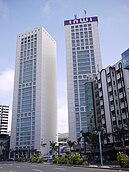



![A man inspects the derailed Decauville locomotive at the scene of the attack that served as the pretext for the French bombardment of Casablanca in 1907.[24][25]](http://upload.wikimedia.org/wikipedia/commons/thumb/5/56/Derailed_locomotive_in_Casablanca_1907.jpg/369px-Derailed_locomotive_in_Casablanca_1907.jpg)

